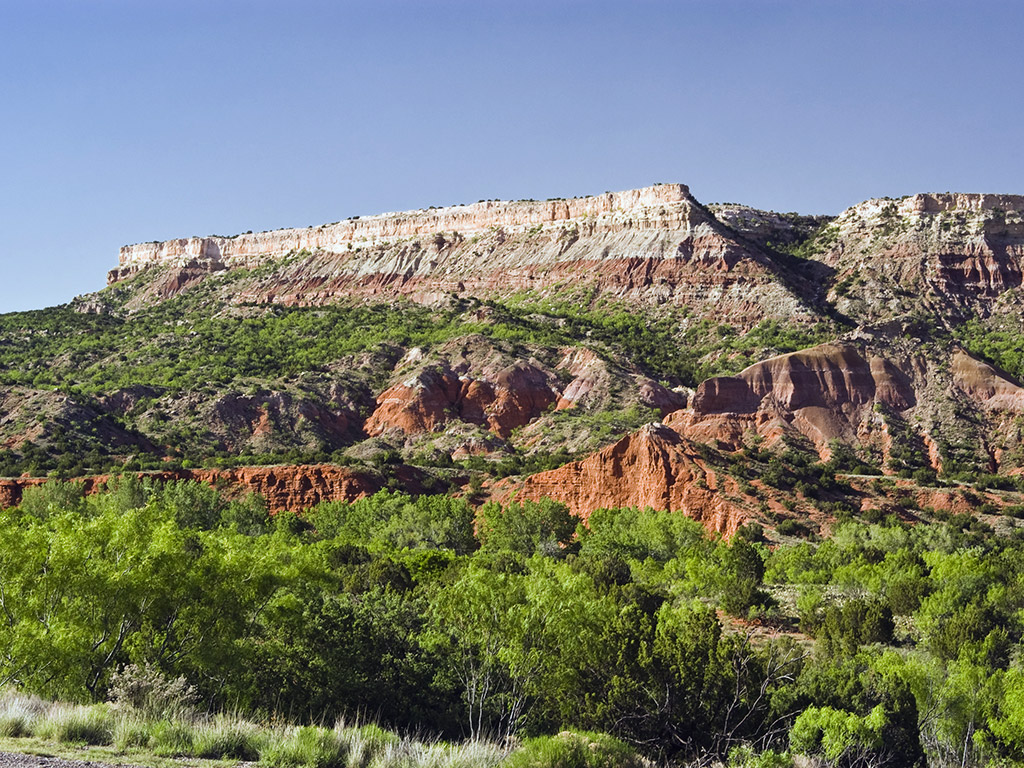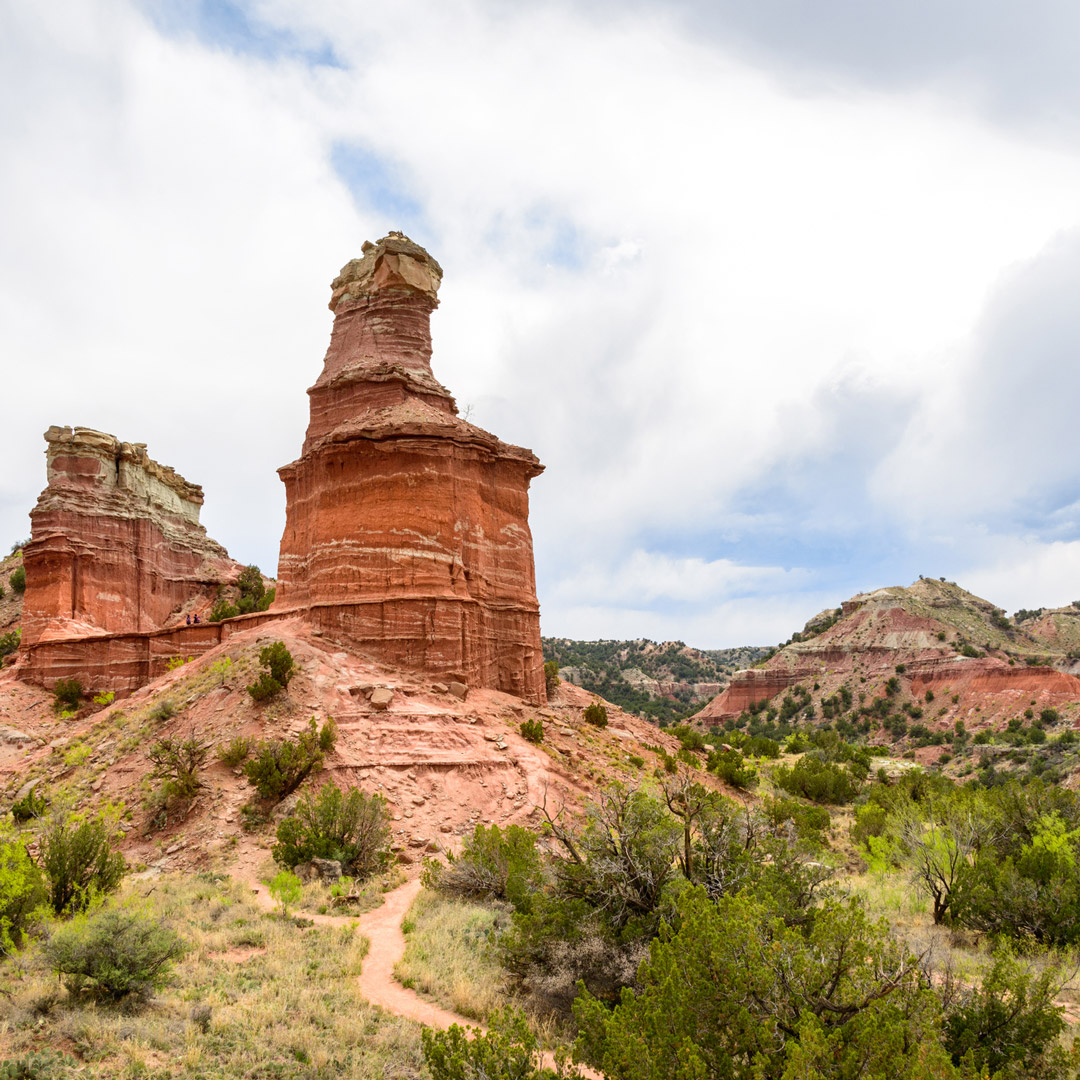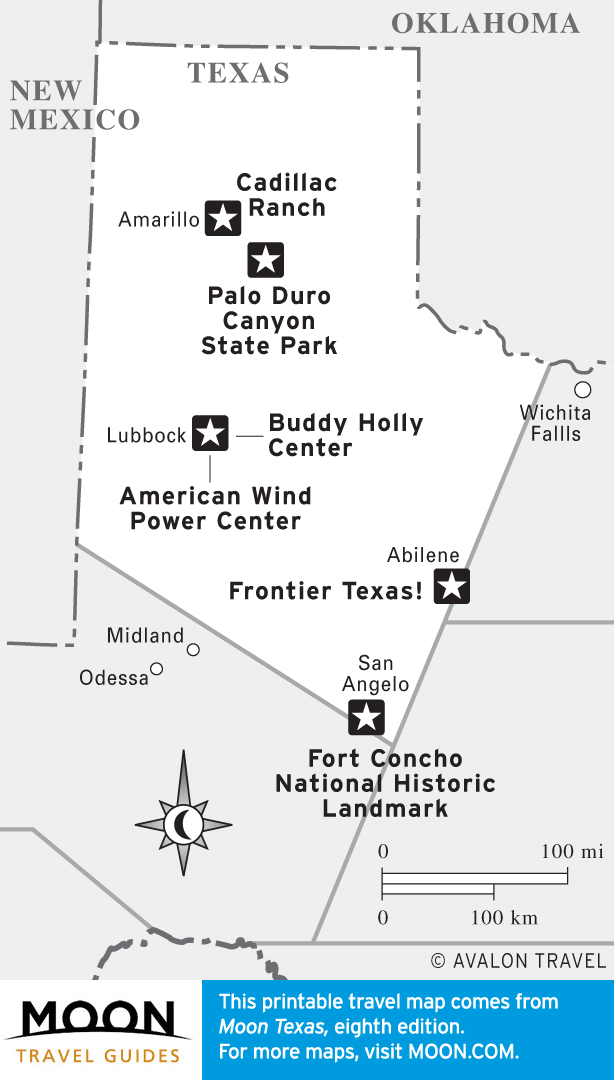Visit Palo Duro Canyon: the Grand Canyon of Texas
Just 20 miles south of Amarillo, Canyon (population 14,887) is home to Palo Duro Canyon State Park, the most fascinating attraction in the Panhandle. The town’s enormous historical museum is also notable, both for its impressive collection of Western art and artifacts and its striking art deco facility.

America’s second-largest canyon is an absolute must. Palo Duro Canyon State Park (11450 Park Rd. 5, 806/488-2227, $5 ages 13 and older) offers colorful and topographical magnificence compared to the stark, level plains above. Though it’s not quite as grand as its Arizona relative, Palo Duro (Spanish for “hard wood”; namely, the abundant mesquite and juniper trees) features a vast expanse of colorful soil and spectacular geographic formations. The stratified colors are particularly intriguing, with sheer cliffs, rock towers, and canyon walls displaying muted hues of red, yellow, and orange exposed by erosion from a tributary of the Red River and the ubiquitous High Plains winds.
Visitors can experience Palo Duro’s topographic splendor by foot, bike, car, or horse year-round. The park’s 18,000 acres offer a topographical getaway unlike any other in the Lone Star State. In addition to hiking and biking, Palo Duro visitors enjoy picnicking and camping, wagon rides, and campfire breakfasts, along with the park’s souvenir shop, interpretive center, and amphitheater.
People have inhabited Palo Duro Canyon for nearly 12,000 years, including the Folsom and Clovis groups who hunted mammoth and giant bison. The area was later occupied by Apaches, Comanches, and Kiowas who sought out the water and animals that gathered at its watering holes.
Newsletter Signup
By clicking ‘Sign Up,’ I acknowledge that I have read and agree to Hachette Book Group’s Privacy Policy and Terms of Use
Early Spanish explorers are credited with “discovering” the canyon and providing its name; however, it wasn’t until 1852 that an American settler first set eyes on its colorful walls. Two decades later, the canyon was a battle site during the Red River War with Native American tribes. Private owners deeded the property to the state in 1933, and for several years afterward, the Civilian Conservation Corps developed it by building road access to the canyon floor, cabins, shelters, the visitors center, and the park headquarters.
The best place to start your Palo Duro adventure is the park’s visitors center. Perched on the upper rim of the canyon, the building is one of several constructed by the CCC and contains an interesting museum with exhibits detailing the canyon’s geographic and cultural history, as well as a store with books and gifts.
The real fun begins as soon as you descend from the flat upper environs to the otherworldly scene below the tabletop surface. A paved road offers an initial glimpse of the canyon’s colorful rock formations and rugged beauty, but the real adventure awaits off the asphalt, where you can get up close views of bizarre and intriguing cacti, wildflowers, and wildlife (primarily lizards and snakes).
Hikers should make a point of taking the Lighthouse Trail (maps are available at the visitors center—the trailhead is marked on the main road). The three-mile-long route is perfect for a morning or afternoon hike, complete with interpretive panels and mesmerizing views, and culminating with a close-up look at the Lighthouse, the park’s distinctive and oft-photographed rock tower. Plan to take a couple hours getting there through scenic surroundings along a rocky and sandy trail. Disregard the plastic strips at the end of the trail, and follow the dirt path upward to the Lighthouse for spectacular panoramic views of the canyon and surrounding countryside. Be sure to carry a hydration pack or bring a gallon of water—it’s always hotter in the canyon.

Mountain bikers have several worthy options to choose from, most notably the Capitol Peak Mountain Biking Trail (recommended) and the Givens, Spicer and Lowry Running Trail, a law firm-sounding yet immensely picturesque four-mile loop throughout the park. Both feature rugged terrain—plenty of loose rock, sand-filled holes, and narrow streambeds—so be sure to keep your eyes in front of you despite the irresistible urge to marvel at the spectacular natural surrounding scenery.
Many visitors choose to go old-school (in Palo Duro’s case, Spanish explorers and cowboy settlers) by experiencing the canyon on horseback. The Old West Stables, located within the canyon, will take you on a guided tour to Timber Creek Canyon and the park’s signature lighthouse tower. To make the required reservations, call 806/488-2180.
Palo Duro Canyon Camping
There’s really only one worthwhile place to camp in the Amarillo area (or even the Panhandle): Palo Duro Canyon State Park. The park offers nearly 80 campsites ($12 nightly, $24 for sites with water and electric). If you plan ahead, you can snag a prized cabin—only seven are available, so they fill up quickly. Three of the cabins have two rooms ($100-125 nightly) and include two single beds and a queen bed, with linens and towels furnished. The park’s four limited-service facilities ($60 nightly) contain two twin beds and a table and chairs, but no towels or linens.
For the RV crowd, the most popular option is Amarillo Ranch RV Park (1414 Sunrise Dr., 806/373-4962, $30), featuring an indoor heated pool, sauna, and hot tub, free coffee and doughnuts, and a private park.

Panhandle-Plains Historical Museum
It’s fitting that the largest history museum in Texas is just a few miles down the road from the enormity of Palo Duro Canyon. The Panhandle-Plains Historical Museum (2503 4th Ave., 806/651-2244, summer Mon.-Sat. 9am-6pm, Sun. 1pm-6pm, winter Mon.-Sat. 9am-5pm, Sun. 1pm-6pm, $10 adults, $9 seniors, $5 children ages 4-12) boasts “more than 500 million years of history across a 26,000 square mile expanse of the Panhandle-Plains.” Indeed, the museum offers a far-reaching collection of diverse heritage-related exhibits, from dinosaurs to Native American culture to pioneers and petroleum. Science and art are also well represented, with displays focusing on archaeology, geology, and Southwestern art.
Particularly memorable exhibits include People of the Plains, showcasing ancient tribe members’ use of the buffalo and an interactive pioneer home, a paleontology display featuring an impressive collection of 200-million-year-old fossils found in the Amarillo area (including a six-foot-long carnivorous amphibian), and an oil exhibit highlighting the importance of petroleum to the Panhandle.
Newsletter Signup
By clicking ‘Sign Up,’ I acknowledge that I have read and agree to Hachette Book Group’s Privacy Policy and Terms of Use
Pin For Later


